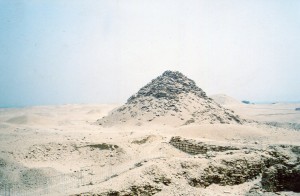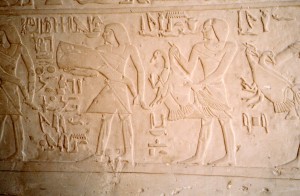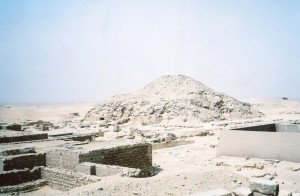And this looks even less impressive. After King Menkaure built the third pyramid at Giza, pyramids became even smaller.
But equally monumental things were happening under the surface. Ancient Egyptians opened up more horizons as they developed new media.
Menkaure’s son and successor, Shepseskaf, was the 4th Dynasty’s last pharaoh. Userkaf founded the 5th Dynasty (2465-2323BCE), and Teti founded the 6th (2323-2150BCE). During this time, when pyramids were smaller and temples were growing in size, literature became more sophisticated–it began to express human life.
Ancient Egyptian literature first recorded offerings in temples. Pharaohs also used it to brag about the enemy butt they kicked to establish themselves. Writing kept both these functions, but 2 major trends developed in the 5th Dynasty.
1. According to Miriam Lichtheim, lists of offerings grew and grew until they became cumbersome. Folks then shortened them into prayers for offerings. Prayers became standard in texts from then-on. Writings in 5th Dynasty tombs now ask, “May offerings be given at–“, and a long list of festivals and auspicious days follows.
2. Lichtheim noted that lists of officials’ ranks and titles became fleshed out with narrative–the autobiography was born. People listed their virtues and great accomplishments: I pleased my father; I pleased my mother; I did my job well, I respected my superiors. They only listed the good stuff. No Keith Richards lauds his willingness to flip off abusive authorities. Ancient Egypt during those Old Kingdom dynasties portrayed an idealized world in which political unity and the regularity of the Nile and the sun reflected a divine order called Maat. Good people get satisfaction in this world, and in eternity.
3. Widsom literature developed. This took the form of a father teaching his son about proper bahavior in an ordered society–Respect your elders. Do not talk loudly. Do not steal. Do not eat more than you should. In this world, Father knows best.
All three forms can seem dry and formulaic. But we have to appreciate the world they were written in. They emerged from older lists of inventories and conquests. Hieroglyphs in tombs were expected to have magical potency, and they were recited like formulas. And they reflected an eternal order.
This is the world that the pyramids’ perfect forms both portrayed and ensured. As Egyptians built them during the Old Kingdom, they developed other media to express this world in more human terms, including sculpture, temple architecture, and literature. All conveyed a positive view of life, and they created a world of beauty with high hopes that it would continue forever.
Ancient Egypt fragmented after the 6th Dynasty. Though this order didn’t endure in politics, Egyptians kept using the Old Kingdom’s art forms. Later dynasties did innovate–sculpture and literature sometimes became more realistic and less idealized, temples became more complex, and texts grew in length and detail. But Egyptians always honored the old standards: the balanced proportions, the pantheon of gods, the centrality of the Pharaoh, and the forms of temples and of hieroglyphs. They returned to this beautiful world created in the Old Kingdom for the next 2,500 years. Tourists from all over the West and Asia go there searching for it–this view of the universe still lives, and captivates people that ancient Egyptians never dreamed of.




{ 5 comments }
i thinck what you wrote was very fasanating and cool to learn about egypt. maybe you should make a kids verson of egypt so when kids learn about it thay can go to your website and lear all about it tell me if you like that or my idea bye!
Thanks for the suggestion. I like your idea very much, and I’ve been thinking about it–the first sentence in my home page says that this site is about maximizing cultural wealth so we can pass the best world we can to kids. I’ve focused on writing for adults so far because children use adults as models, and if we develop a sense of wonder about the world, kids will be inspired to fall in love with learning. This isn’t happening in schools as much as it could, so parents need to pick up the torch. Ideally, I should be writing directly to kids too, and I’ll do that if enough people want me to. Meanwhile, kids can click on the “gallery” button on this site and see lots of photos from around the world, and get a glimpse of how enjoyable it is to study the cultures we share the planet with.
wite a kids verson it will be amazing
were you in egypt
Yeah, I was in Egypt in 2007. I feel a lot of personal connections with Egypt, and with every place I’ve written about and taken pictures of.
Comments on this entry are closed.